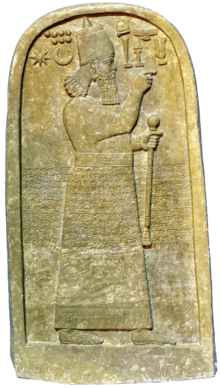Apiashal
Apiashal (Akkadian: 𒀀𒉿𒀀𒊩, romanized: A-pi-a-ŠAL) had been an early monarch (fl. c. 2205 BC — c. 2192 BC) of the Early Period of Aššūrāyu (Assyria) according to the Assyrian King List (AKL).[1][2] He is listed within the section of the AKL as the last of whom, "altogether seventeen kings, tent dwellers."[1][2] This section shows marked similarities to the ancestors of the First Babylonian dynasty.[2] The AKL also states that Apiashal had been preceded by his father Ushpia (fl. c. 2218 BC — c. 2205 BC.) Additionally, the AKL states that Apiashal had been succeeded by his son Hale (fl. c. 2192 BC — c. 2179 BC.)
| Apiashal | |
|---|---|
| Monarch of Aššūrāyu | |
| Reign | fl. c. 2205 BC — c. 2192 BC |
| Predecessor | Ushpia |
| Successor | Hale |
| Father | Ushpia |
Apiashal is also listed within a section of the AKL as the first out of the ten, "kings whose fathers are known.” This section (which in contrast to the rest of the list) had been written in reverse order—beginning with Aminu (fl. c. 2088 BC — c. 2075 BC.) and ending with Apiashal, "altogether ten kings who are ancestors"[1][2]—has often been interpreted as the list of ancestors of the Amorite Šamši-Adad I[2] (fl. c. 1754 BC — c. 1721 BC) who had conquered the city-state of Aššur.[3] In keeping with this assumption, scholars have inferred that the original form of the Assyrian King List had been written (among other things) as an, “attempt to justify that Šamši-Adad I was a legitimate ruler of the city-state Aššur and to obscure his non-Assyrian antecedents by incorporating his ancestors into a native Assyrian genealogy.”[2] However, this interpretation has not been accepted universally; the Cambridge Ancient History rejected this interpretation and instead interpreted the section as being that of the ancestors of Sulili (fl. c. 2075 BC — c. 2062 BC.)[4] Very little is otherwise known of Apiashal's reign.
| Preceded by Ushpia |
Monarch of Aššūrāyu fl. c. 2205 BC — c. 2192 BC |
Succeeded by Hale |
See also
- Timeline of the Assyrian Empire
- Early Period of Assyria
- List of Assyrian kings
- Assyrian continuity
- Assyrian people
- Assyria
References
- Glassner, Jean-Jacques (2004). Mesopotamian Chronicles. Society of Biblical Literature. p. 137. ISBN 1589830903.
- Meissner, Bruno (1990). Reallexikon der Assyriologie. 6. Berlin: Walter de Gruyter. p. 103. ISBN 3110100517.
- Van De Mieroop, Marc (2004). A History of the Ancient Near East ca. 3000-323 BC (2nd ed.). Blackwell Publishing. p. 107. ISBN 9781405149112.
- Hildegard Levy, "Assyria c. 2600-1816 B.C.", Cambridge Ancient History. Volume 1, Part 2: Early History of the Middle East, 729-770, p. 745-746.)
